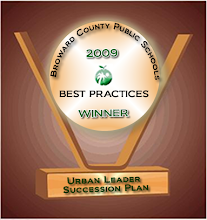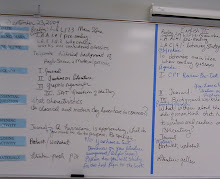1)Examine the results of the latest writing prompt administered at your school. Create a list of students by rubric scores. Intensify and differentiate instruction for the students based on this latest data point.
2)Revisit your list of the top 45% in science to ensure that all students are currently performing at the levels they should. Intensify the enrichments these students receive.
3)Revisit your list of students who received an Achievement Level 2 last year in reading or mathematics (bubble students). Provide additional support to ensure they move to the next level.
4)Revisit your list of students who were retained last year in any grade (3-10). Look at the available data points to see what their progress has been like this year. Remember to get a learning gain—they must go up an achievement level.
5)Look at the tutorial/enrichment lists. Look at the available data points for these students. Has there been progress? If not, what changes need to be made?
6)Revisit your list of students who scored at Achievement Levels 3, 4, or 5. Look at the available data points to see if their progress is in the upward direction. What will you do in the last 9 weeks to maintain or increase their achievement level?
7)Senior high schools should look at all the students who are currently retained in the computer but are attending night school or participating in virtual school to ensure that if they complete the credit needed, the student is appropriately promoted in the computer.
8)Make sure your teachers are fluent with the Item Specifications (Test Specs). If not provide immediate professional development because this is crucial during this crunch period.
9)Examine exposure rates your students are having to Informational Text. If you are satisfied with the rate and results, continue. If not, make adjustments now to increase the exposure. Use all of your resources effectively and efficiently.
10)How many points are you away from the next accountability grade? What do you feel is your probability rate of achieving the next level? What are you doing differently during the next nine weeks to maintain standards where mastery was achieved and improve standards that were weak?
For more informations see: Effective Data Usage : Utilizing Data to Effectively Drive Instruction Powerpoint
Wednesday, December 17, 2008
Friday, November 21, 2008
Thursday, November 20, 2008
Percent of Students below grade level in Reading
Recap of what Intern Principals shared in podcast:
• Double Dosing
• Tutoring after School
• Introduce Reading Strategies across Curriculum
and in Electives
• Start Writing Prompts 9th Grade Short/Extended
Responses
• Pullout services for lowest percentile
• Identify Bubble Student in all levels/categories/subgroups
• School-wide Literacy Program
• Content area reading training for staff
• SSR in Content Area
• Double Dosing
• Tutoring after School
• Introduce Reading Strategies across Curriculum
and in Electives
• Start Writing Prompts 9th Grade Short/Extended
Responses
• Pullout services for lowest percentile
• Identify Bubble Student in all levels/categories/subgroups
• School-wide Literacy Program
• Content area reading training for staff
• SSR in Content Area
Kimberly Fernander
Dillard Elementary School
• Provide intensive instruction in the areas of Reading and Writing
• Provide instructional material that meet specific needs of the students
• Monitor bi-weekly assessments to determine academic growth
• Provide students with the opportunity to participate in the Extended Learning Opportunities after school and Saturday tutorial programs
• Use specials teachers push-in and reading resource specialist/curriculum facilitator to provide additional assistance within the classrooms
• Reflect differentiated instruction in lesson plans, small groups, double/triple dose, and reading centers to meet needs of all students
• Implementation of New Reading Series, inclusive of intervention programs
• Implementation of research based programs aligned to the struggling readers chart to address the five areas of reading for select students
Dillard Elementary School
• Provide intensive instruction in the areas of Reading and Writing
• Provide instructional material that meet specific needs of the students
• Monitor bi-weekly assessments to determine academic growth
• Provide students with the opportunity to participate in the Extended Learning Opportunities after school and Saturday tutorial programs
• Use specials teachers push-in and reading resource specialist/curriculum facilitator to provide additional assistance within the classrooms
• Reflect differentiated instruction in lesson plans, small groups, double/triple dose, and reading centers to meet needs of all students
• Implementation of New Reading Series, inclusive of intervention programs
• Implementation of research based programs aligned to the struggling readers chart to address the five areas of reading for select students
Monday, October 20, 2008
Getting Down to Business
In an effort to meet our District's initiatives in making AYP, I have asked the Intern Principals to share successful AYP strategies on this blog.
Each month we will focus on a different indicator for meeting AYP. All topics will be archived for review.
We would like to invite all administrators to add strategies and comments each month.
Sherry Rose, Director
Leadership/Non-Instructional Development
Each month we will focus on a different indicator for meeting AYP. All topics will be archived for review.
We would like to invite all administrators to add strategies and comments each month.
Sherry Rose, Director
Leadership/Non-Instructional Development
Leadership Program/AYP Conversations

Increase Graduation Rate by 1%--Click here
Recap of what Intern Principals shared in podcast:
• Find better ways to code/track
• Use Western’s Exit Option Program
• Credit Recovery Program
• APEX
• Identify Fourth- Year Students in Danger and get in APEX Programs
David Watkins
Intern Principal Whiddon-Rogers Education Center
• Offer and discuss in a meaningful way diploma options such as Standard and Exit Option.
• Schedule quarterly counseling sessions with assigned guidance counselor to discuss status, progress and requirements.
• Participate in PSAT, SAT and other post-secondary assessments.
• Ensure students who have not passed FCAT are scheduled into Intensive Reading and/or Intensive Math.
• Use remediation activities for 11th and 12th graders who have not passed the FCAT.
Subscribe to:
Comments (Atom)








